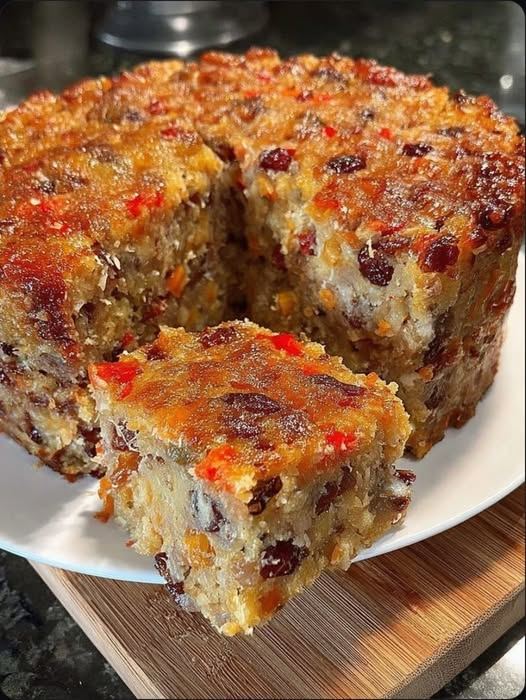Fruitcake has always been one of those desserts people either love or loathe—usually the latter. For years, I was firmly in the “no, thanks” camp. The dense, dry texture and overpowering sweetness of the traditional versions never appealed to me. Every holiday season, I’d politely decline a slice, secretly wondering how anyone could enjoy something so brick-like. Then one year, almost by accident, I stumbled upon a recipe that completely changed my mind. What began as a small experiment in the kitchen turned into what I now call my “Never Fail Fruit Cake”—a perfectly moist, candy-like version of a classic that’s become a family staple..

This isn’t your grandmother’s heavy, rum-soaked loaf. It’s bright, chewy, and filled with texture—soft dates, crunchy pecans, and colorful candied fruits bound together by the rich creaminess of sweetened condensed milk. Every bite feels like a celebration, a mix of nostalgia and indulgence. The best part? It’s practically foolproof. Whether you’re a seasoned baker or a kitchen novice, this recipe delivers consistent results every single time.
The secret lies in the balance of ingredients. Start with the foundation: one pound each of candied cherries, candied pineapple, and pitted dates. These bring sweetness and moisture, ensuring the cake never turns out dry. Add a pound of chopped pecans for that satisfying crunch, and then four packages of flaked coconut to create the perfect chewy structure. Three tablespoons of flour help bind everything together just enough, while two cans of sweetened condensed milk act as both the sweetener and the glue that holds the fruit and nuts in a luscious, sticky embrace.
Preparation is simple, but precision matters. Preheat your oven to a low and steady 300°F (150°C). Line a ten-inch tube pan with greased parchment paper—this step is crucial because the cake’s texture is dense, and you don’t want it to stick. Lightly grease the sides, then set the pan aside while you prepare the mixture.
In a large bowl, combine the chopped fruits and nuts. This is where the fun begins. Mix everything with your hands instead of a spoon; it helps distribute the ingredients more evenly and ensures every handful of batter gets an even share of fruit and nuts. Add the coconut and toss it through the mixture until it looks colorful and uniform. Sprinkle in the flour and blend gently. Finally, pour in the sweetened condensed milk, and stir until the entire bowl of ingredients transforms into a thick, glossy mass.
When you pack the mixture into the pan, press it down firmly with a spatula or your hands. This cake doesn’t rise, so compacting it tightly ensures a smooth, even texture. Slide it into the oven and bake for one and a half hours. You’ll know it’s ready when the top turns a deep golden brown and the edges begin to pull away from the sides.
When it’s done, resist the urge to dig in right away. Let it cool just long enough to handle—still slightly warm, but not hot. Run a knife around the edge, release the sides of the tube pan, and carefully remove the bottom and parchment paper. What you’ll reveal is a cake that gleams with color and smells like caramelized fruit and toasted coconut.
Unlike traditional cakes, this one doesn’t dry out with time. In fact, it gets better. Wrapped tightly and stored in the fridge, it can last indefinitely. Some claim that the flavors deepen and meld even more after a few days. I tend to agree. Slice it cold, and it feels dense and candy-like; let it come to room temperature, and it softens into something rich, chewy, and addictively moist.
What I love most about this recipe is its flexibility. You can swap out ingredients depending on your taste or what’s in your pantry. Don’t have cherries? Try dried cranberries for a tart edge. Prefer almonds over pecans? Go for it. I’ve even replaced part of the condensed milk with honey for a slightly lighter sweetness. Every variation brings a new twist, but the cake’s signature texture and stability never fail.
Over time, this fruitcake has evolved from a curiosity into a family tradition. Every holiday season, I make at least two—one for sharing and one for hoarding. Friends who once rolled their eyes at the mention of fruitcake now beg for a slice. Even my kids, who usually turn up their noses at anything containing dried fruit, devour it. There’s something about the chewy sweetness and buttery richness that wins everyone over.
And while it’s perfect for Christmas, it’s far too good to limit to one season. I’ve baked it for summer picnics, potlucks, and even birthdays. It holds up beautifully in lunchboxes and makes an excellent edible gift. Because it keeps so well, you can make it weeks—or even months—in advance. A wrapped loaf tucked in the fridge feels like a secret stash of sweetness waiting for the right occasion.
What started as an attempt to redeem a much-maligned dessert became something of a culinary revelation for me. It reminded me that food, like people, deserves a second chance. Maybe the fruitcakes I’d known growing up weren’t bad; maybe they were just misunderstood, victims of poor recipes and careless preparation. When made with love and attention, the humble fruitcake can be extraordinary—dense with history, flavor, and joy.
Now, every time I pull one of these golden loaves from the oven, I think about how my attitude toward it changed. It’s not just about baking—it’s about patience, tradition, and the quiet satisfaction that comes from perfecting something once dismissed. My kitchen fills with the aroma of toasted coconut and caramelized fruit, and I know that, for at least a few weeks, there will always be something sweet and homemade waiting in the fridge.
This cake has earned its place in my top ten desserts of all time—not for its complexity, but for its simplicity and heart. It’s proof that even the most overlooked recipes can shine when treated with care. So if you’ve ever sworn off fruitcake, consider this your sign to try again. This one doesn’t crumble, doesn’t dry, and definitely doesn’t disappoint.
One slice, and you’ll understand why I call it the “Never Fail Fruit Cake.” It’s the dessert that converted a skeptic, turned a holiday cliché into a year-round favorite, and reminded me that sometimes, the best recipes are the ones that surprise you the most.




